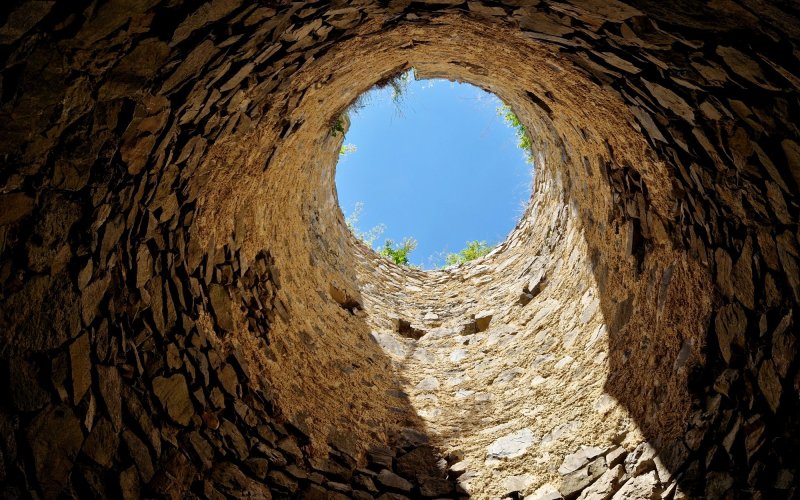It was probably Aristotle who first stated that from the bottom of a deep enough well, even on a sunny day, the stars could be seen. This statement was later repeated many times. His assumption was that at the bottom of the well, the shadow would be so deep and dark that the sun would cease to obstruct observation and the stars could be seen.
However, it is complicated and dangerous to climb into a deep, dry well to verify this. From the bottom of an undrained well, stargazing is even more difficult. If you don’t have an easily accessible well in your garden, you can imitate the impression of such a sighting. Put a paper roll of kitchen towels to your eye and look through it at the sky. Do not look at or near the sun! The result will be similar to looking from the bottom of a well. To your surprise, you won't see any stars, but a clear blue sky.
The stars send light to us across a vast distance of many light years. The more light that comes to us from a star, the brighter it looks. We measure the brightness of stars in terms of a value called magnitude. The lower the magnitude, the brighter the object. The brightest star in the sky, Sirius, has a magnitude of −1.46. Polaris, the 50th brightest star in the sky, has a magnitude of 2. If we want to compare this to the brighter objects we can see in the sky, the full moon has a magnitude of −12. The daytime sky has a magnitude of about −4. That’s why we can see the moon with the naked eye, but not Sirius.
The blue colour of the sky is caused by Rayleigh scattering, which is the scattering of sunlight on nitrogen and oxygen atoms. Blue light, which has a shorter wavelength, is scattered much more than red light. That’s why we perceive the sky as blue. This scattering also causes the sky to glow uniformly everywhere. Looking through a pipe or down a well does nothing to remove this brightness. On the contrary, in contrast to the gloom at the bottom of the well, the sky seems to glow all the more brightly.
Of course, a deep well can help by shielding distracting side light sources, and will allow you to better focus on the subject, if it happens to be above the mouth of the well. Undoubtedly, stars at night will be perfectly visible from the bottom of the well.
However, under certain circumstances, the stars are visible during the day, and there is no need to climb into the well to see them. Just arm yourself with a suitable telescope. As well as allowing us to see faintly glowing objects in the night sky that we wouldn’t otherwise see, it can also help with star resolution in the daytime. We can use an infrared filter to block out much of the blue sky radiation.
For example, Australia’s Macquarie University built a telescope called the Huntsman. It is comprised of 10 highly sensitive 400 mm Canon lenses, rigged together to observe the same patch of sky. Huntsman allows us to see the brightest stars in the sky even on a sunny day. This brings a range of amazing possibilities.
Some stars cannot be seen all year round, but only when they are in the night sky. For part of the year, when they are in the daytime sky, their brightness is covered by the brightness of the Sun, and astronomers cannot see what is happening to the stars. They would like to see this for variable stars, for example, or stars with suspected exoplanets. There can also be spectacular events in the daytime sky when a star turns into a nova or supernova, and it would be a pity to miss this spectacle. For example, the star Betelgeuse, just 640 light years away, is already in the twilight of its life, and astronomers expect it to turn into a supernova at any moment. More precisely, any astronomical moment, which is somewhere between “now” and 100,000 years from now. Betelgeuse is too close to the Sun to be observed directly for half the year, and daily observations would allow it to be monitored for a full year.
Last but not least, daily observations can be used to track satellites and their movements in orbit. As the number of man-made bodies around the Earth grows, it is important to keep track of where each satellite is right now and what state it is in. Daily observations will improve space situational awareness and contribute to the safety of operations in near space.
Want to ask something?
Send us an e-mail with the subject “Physics mysteries” to the address:
We can't wait to tackle your interesting questions!





